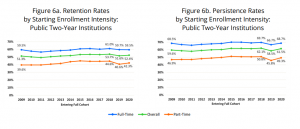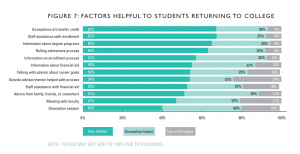Advance CTE’s “Research Round-Up” blog series features summaries of relevant research reports and studies to elevate evidence-backed Career Technical Educational (CTE) policies and practices and topics related to college and career readiness. This month’s topic, Addressing Student Stop-Out, supports a vision for the future of CTE where statewide systems and supports are in place for each learner to feel welcome in, supported by and prepared to succeed in the career preparation ecosystem, and identifies some effective strategies for supporting learners to increase postsecondary retention and completion.
Defining “Stop-Out” and Learner Demographics
“Stopped out” students are those adult learners with some college experience but no credentials.
According to a recent National Student Clearing House report, approximately 39 million individuals in the United States qualify as having Some College, but No Credentials (SCNC). Unfortunately, this often leaves learners with the debt of attending a postsecondary institution or program without any benefits from earning a credential.
Based on 2020 National Student Clearinghouse data, learners enrolled full-time achieved a retention rate of 59.5 percent and a persistence rate of 68.7 percent. Those metrics, however, were significantly lower for part-time learners, at 42.3 percent and 49.3 percent respectively.
Retention is defined in this report as the continued enrollment (or degree completion within the same higher education institution in the fall terms of a learner’s first and second year. Persistence is defined in this report as the continued enrollment (or degree completion) at any higher education institution– including one different from the institution of the learner’s initial enrollment– in the fall terms of their first and second year.
Who is the most vulnerable to stopping out? Data trends from the National Student Clearinghouse show that racial and ethnic minorities are overrepresented among SCNC learners. Based on a subset of the 39 million SCNC students who entered college in 2013 or later, this report found that Black and Latinx SCNC students collectively made up 42.8 percent, compared to 34.3 percent of undergraduates.

Source: (National Student Clearinghouse 2022)
Wraparound Services and Other Supports to Address Student Stop-Out
Persevering to Completion, a report published in collaboration with the Lumina Foundation and Higher Ed Insight (HEI), uses survey data to understand better the experiences of SCNC learners and the supports that helped them return to college.
For this study, HEI surveyed students from a cohort identified by the National Student Clearinghouse as having stopped out and then returned to college between 2013 and the end of 2018. In 2021, HEI surveyed a subgroup of these students to learn more about whether they’d completed a credential in the interim, what their reasons were for re-enrolling, and what happened when they re-enrolled.
Among the key findings:
- Students reenrolled for personal and professional reasons;
- Financial barriers were significant factors for students completing their credentials;
- Flexible institutional supports like academic counseling, opportunities for credit transfer and a rolling admissions process had an impact on adult learners; and
- Key supports related to the timing and delivery of courses included the availability of online and/or hybrid courses, classes that were offered frequently, and convenient class times.
Factors that respondents identified as helping to facilitate their return to college included:
- Proactive outreach by postsecondary institutions to their stop-outs and other adults who are researching degree programs;
- Messaging focused on the needs of returning adult students, particularly regarding the cost and time required to complete a credential;
- Access to easily navigable admissions and degree program information; and
- Readily available assistance to answer questions and support returning students through the process of re-enrolling.

State CTE leaders can lead on this issue by taking a supporting postsecondary leaders in systemic evalutions of current supports for stopped out learners to facilitate their re-enrollment. Additional resources about the strategies to equitable support postsecondary learners can be found in the Learning that Works Resource Center.
Amy Hodge, Policy Associate
